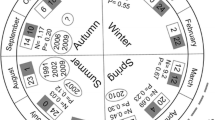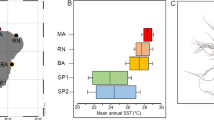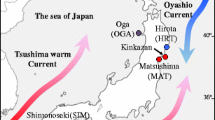Abstract
Understanding the nutrient uptake kinetics of kelp populations will contribute to an improved understanding of environmental adaptation and the breeding of new cultivars. In this study, we examined the morphological characteristics, carbon (C) and nitrogen (N) contents, and NO3 −–N and NH4 +–N uptake kinetics of Undaria pinnatifida sporophytes cultivated at six industrial farms throughout Japan. We detected significant differences in morphology among sites. At Matsushima Bay (northern Pacific coast of Japan), where autumnal seawater temperatures fall in concert with increasing nutrient concentrations, sporophytes were significantly larger than at other sites from December to February. The C content of the sporophytes was seasonally stable at all of the locations, but the N content of sporophytes declined after February due to a decrease in seawater nutrients. We compared the uptake kinetics of NO3 −–N and NH4 +–N among cultivation sites. V max and K s, which are Michaelis–Menten parameters that measure adaptation to nutrient concentrations, were highest in the Seto Inland Sea and lowest in the northern sector of the Sea of Japan. The V max/K s ratio is a measure of adaptation to low nutrient concentrations; the highest values were measured in the northern sector of the Sea of Japan. The parameter ranges were broader than those previously reported for invasive populations of U. pinnatifida in other parts of the world. Thus, we detected population-level adaptations to the various nutrient conditions in Japanese waters, and these results suggest the existence of ecotypes according to nutrient uptake kinetics. The different populations may be used to provide sources of genetic material that could be of value in breeding programmes by improving productivity and quality.





Similar content being viewed by others
References
Ahn O, Petrell RJ, Harrison PJ (1998) Ammonium and nitrate uptake of Laminaria saccharina and Nereocystis luetkeana originating from a salmon sea cage farm. J Appl Phycol 10:333–340
Akita Prefecture (2013) Report of Akita Prefectural Institute of Fisheries. pp 380–381
Bloom AJ (1994) Crop acquisition of ammonium and nitrate. In: Boote KJ, Bennett JM, Sinclair TR, Paulsen GM (eds) Physiology and determination of crop yield. ASA, CSA, SSSA, Madison, pp 303–310
Bracken MES, Williams SL (2013) Realistic changes in seaweed biodiversity affect multiple ecosystem functions on a rocky shore. Ecology 94:1944–1954
Bracken MES, Jones E, Williams SL (2011) Herbivores, tidal elevation, and species richness simultaneously mediate nitrate uptake by seaweed assemblages. Ecology 92:1083–1093
Braga AC, Yoneshigue–Valentin Y (1996) Nitrogen and phosphorus uptake by the Brazilian kelp Laminaria abyssalis (Phaeophyta) in culture. Hydrobiologia 326/327:445–450
Buschmann AH, Troell M, Kautsky N (2001) Integrated algal farming: a review. Cah Biol Mar 42:83–90
Campbell SJ, Bité JS, Burridge TR (1999) Seasonal patterns in the photosynthetic capacity, tissue pigment and nutrient content of different developmental stages of Undaria pinnatifida (Laminariales, Phaeophyta) in Port Phillip Bay, South-Eastern Australia. Bot Mar 42:231–241
Casas GN, Piriz ML (1996) Surveys of Undaria pinnatifida (Laminariales Phaeophyta) in Golfo Nuevo, Argentina. Hydrobiologia 326/327:213–215
Castric-Fey A, Beaupoil C, Bouchain J, Pradier E, L’Hardy-Halos MT (1999) The introduced alga Undaria pinnatifida (Laminariales, Alariaceae) in the rocky shore ecosystem of the St. Malo area: growth rates and longevity of the sporophyte. Bot Mar 42:83–96
Cecere E, Petroccelli A, Saracino OD (2000) Undaria pinnatifida (Fucophyceae, Laminariales) spread in the central Mediterranean: its occurrence in the Mar Piccolo of Taranto (Ionian Sea, southern Italy). Cryptogam Algol 21:305–309
Chapman ARO, Craigie JS (1977) Seasonal growth in Laminaria longicruris: relations with dissolved inorganic nutrients and internal reserves of nitrogen. Mar Biol 44:85–96
Dan A, Ohno M, Matsuoka M (2015) Changes of the research and development on the resources of Undaria and Laminaria in the culture ground of Tokushima coasts. Bull Tokushima Pref Fish Res Inst 10:25–48 (in Japanese with English abstract)
Dean PR, Hurd CL (2007) Seasonal growth, erosion rates, and nitrogen and photosynthetic ecophysiology of Undaria pinnatifida (Heterokontophyta) in southern New Zealand. J Phycol 43:1138–1148
Dean TA, Jacobsen FR (1986) Nutrient-limited growth of juvenile kelp, Macrocystis pyrifera, during the 1982–1984 “El Niño” in southern California. Mar Biol 90:597–601
Dellatorre FG, Amoroso R, Saravia J, Orensanz JM (2014) Rapid expansion and potential range of the invasive kelp Undaria pinnatifida in the Southwest Atlantic. Aquat Invasions 9:467–478
Edwards MS, Estes JA (2006) Catastrophe, recovery and range limitation in NE Pacific kelp forests: a large-scale perspective. Mar Ecol Prog Ser 320:79–87
Forde BG (2000) Nitrate transport in plants: structure, function and regulation. Biochim Biophys Acta 1465:219–235
Fujiwara T (2012) Undaria pinnatifida, U. undariodes, U. peterseniana. In: Watanabe M (ed) Handbook of algae—their diversity and utilization. NTS Inc, Tokyo, pp 585–589 (in Japanese)
Fujiwara T, Kobayashi S, Kunii M, Uno N (2006) Nitrogen and phosphorus in Seto Inland Sea: their origin, budget and variability. Bull Coast Oceanogr 43:129–136
Gao X, Agatsuma Y, Taniguchi K (2013a) Effect of nitrate fertilization of gametophytes of the kelp Undaria pinnatifida on growth and maturation of the sporophytes cultivated in Matsushima Bay, northern Honshu, Japan. Aquac Int 21:53–64
Gao X, Endo H, Taniguchi K, Agatsuma Y (2013b) Genetic differentiation of high-temperature tolerance in the kelp Undaria pinnatifida sporophytes from geographically separated populations along the Pacific coast of Japan. J Appl Phycol 25:567–574
Harrison PJ, Hurd CL (2001) Nutrient physiology of seaweeds: application of concepts to aquaculture. Cah Biol Mar 42:71–82
Harrison PJ, Parslow JS, Conway HL (1989) Determination of nutrient uptake kinetic parameters: a comparison of method. Mar Ecol Prog Ser 52:301–312
Hay CH, Luckens PA (1987) The Asian kelp Undaria pinnatifida (Phaeophyta: Laminariales) found in a New Zealand harbour. N Z J Bot 25:364–366
Healey FP (1980) Slope of the Monod equation as an indicator of advantage in nutrient competition. Microbial Ecol 5:281–286
Hein MH, Pedersen MF, Sand-Jensen K (1995) Size-dependent nitrogen uptake in micro- and macroalgae. Mar Ecol Prog Ser 118:247–253
Hurd CL, Dring MJ (1990) Phosphate uptake by intertidal fucoid algae in relation to zonation and season. Mar Biol 107:281–289
Hurd CL, Harrison PJ, Bischof K, Lobban CS (2014) Seaweed ecology and physiology, 2nd edn. Cambridge University Press, Cambridge
Imai I, Yamaguchi M, Hori Y (2006) Eutrophication and occurrences of harmful algal blooms in the Seto Inland Sea, Japan. Plankon Benthos Res 1:71–84
Ishii D, Yanagi T (2006) Pacific Ocean originated phosphorus and nitrogen in the Seto Inland Sea, Japan. Bull Coast Oceanogr 43:119–127
Ishikawa Y (1991) Analysis of quantitative traits in cultured Wakame for breeding. Fish Genet Breed Sci 16:19–24 (in Japanese)
Ishikawa Y (1994) Quantitative traits in cultivated Wakame Undaria pinnatifida. Fish Genet Breed Sci 20:9–16 (in Japanese)
Jackson GA (1977) Nutrients and production of giant kelp, Macrocystic pyrifera, off southern California. Limnol Oceanogr 22:979–995
Kaas R, Perez R (1989) Study of the intensive culture of Undaria on the coast of Brittany. Outdoor seaweed cultivation. In: The Proceedings of the Second Workshop of Cost 48 Subgroup 1:31–33
Kato T, Nakahisa Y (1962) A comparative study on two local forms of Undaria pinnatifida Sur., a brown alga, grown in a culture ground. Bull Jpn Soc Sci Fish 28:998–1004 (in Japanese with English abstract)
Kito H, Taniguchi K, Akiyama K (1981) Morphological variation of Undaria pinnatifida (Harvey) Suringar-II. Comparison of the sporophyte morphology of cultured F1 plants originated from parental types of two different morphologies. Bull Tohoku Reg Fish Res Lab 42:11–18 (in Japanese with English abstract)
Li JY, Murauchi Y, Ichinomiya M, Agatsuma Y, Taniguchi K (2007) Seasonal changes in photosynthesis and nutrient uptake in Laminaria japonica (Laminariaceae: Phaeophyta). Aquac Sci 55:587–597
Li JY, Agatsuma Y, Nagai T, Sato Y, Taniguchi K (2009) Differences in resource storage pattern between Laminaria longissima and Laminaria diabolica (Laminariaceae; Phaeophyta) reflecting their morphological characteristics. J Appl Phycol 21:215–224
Ministry of Agriculture, Forestry and Fisheries (MAFF) (2013) Annual report of Ministry of Agriculture, Forestry and Fisheries 2013. Annual report of catch statistics on fishery and aquaculture. Ministry of Agriculture, Forestry and Fisheries, Tokyo, Japan
Nabata S, Takiya A, Tada M (2003) On the decreased production of natural kelp, Laminaria ochotensis in Rishiri Island, northern Hokkaido. Sci Rep Hokkaido Fish Exp Stn 64:127–136 (in Japanese with English abstract)
Nakata A, Yagi H, Miyazono A, Yasunaga T, Kawai T, Iizumi H (2001) Relationships between sea surface temperature and nutrient concentrations in Oshoro Bay, Hokkaido, Japan. Sci Rep Hokkaido Fish Exp Stn 59:31–41 (in Japanese with English abstract)
Nakayama A (2011) Review of characteristics on the current and nutrients distribution of Seto Inland Sea, and development of the hydrodynamic model coupled with primary production model applied to this region. Bull Fish Res Agenda 34:49–70 (in Japanese with English abstract)
Nanba N, Fujiwara T, Kuwano K, Ishikawa Y, Ogawa H, Kado R (2011) Effect of water flow velocity on growth and morphology of cultured Undaria pinnatifida sporophytes (Laminariales, Phaeophyceae) in Okirai Bay on the Sanriku coast, northeast Japan. J Appl Phycol 23:1023–1030
Nishida Y (1999) Relation between hydrographic conditions and harvest of konbu kelps. In: Taniguchi K (ed) The ecological mechanism of “Isoyake” and marine afforestation (in Japanese). Kouseisha Kouseikaku, Tokyo, pp 50–61
Niwa K (2015) Experimental cultivation of Undaria pinnatifida for double cropping in Pyropia farms around Akashi Strait, Hyogo Prefecture. Jpn J Phycol 63:90–97 (in Japanese with English abstract)
Niwa K, Harada K (2016) Experiment on forcing cultivation of Undaria pinnatifida sporophytes in the Seto Inland Sea by using free-living gametophytes cultured in laboratory. Jpn J Phycol 64:10–18 (in Japanese with English abstract)
Onishi M, Ohtani K (1997) Volume transport of the Tsushima warm current, west of Tsugaru Strait bifurcation area. J Oceanogr 53:27–34
Pang SJ, Wu CY (1996) Study on gametophyte vegetative growth of Undaria pinnatifida and its application. Chin J Oceanol Limnol 14:205–210
Perez R, Kass R, Barbaroux O (1984) Culture expérimentales de l’algue Undaria pinnatifida sur les côtes de France. Sci Pêche 343:3–16 (in French with English abstract)
Pérez-Cirera JL, Salinas JM, Cremades J, Bárbara I, Granja A, Veiga AJ, Fuertes C (1997) Cultivo de Undaria pinnatifida (Laminariales, Phaeophyta) en Galicia. Nova Acta Cient Compostelana (Biol) 7:3–28 (in Spanish with English abstract)
Perini V, Matthew E, Bracken S (2014) Nitrogen availability limits phosphorus uptake in an intertidal macroalga. Oecologia 175:667–676
Peteiro C, Freire O (2011) Effect of water motion on the cultivation of the commercial seaweed Undaria pinnatifida in a coastal bay of Galicia, Northwest Spain. Aquaculture 314:269–276
Peteiro C, Freire O (2012) Outplanting time and methodologies related to mariculture of the edible kelp Undaria pinnatifida in the Atlantic coast of Spain. J Appl Phycol 24:1361–1372
Saito Y (1972) On the effect of environmental factors on morphological characteristics of Undaria pinnatifida and the breeding of hybrids in the genus Undaria. In: Abbott IA, Kurogi M (eds) Contributions to the systematics of benthic marine algae of the North Pacific. Japanese Society of Phycology, Kobe, pp 117–132
Sakanishi Y, Iizumi H (1998) Photosynthesis–temperature relationship of Laminaria longissima Miyabe (Laminariales, Phaeophyta). Jpn J Phycol 46:105–110 (in Japanese with English abstract)
Sanderson JC (1990) A preliminary survey of the distribution of the introduced macroalga, Undaria pinnatifida (Harvey) Suringar on the east coast of Tasmania. Bot Mar 33:153–157
Sato Y, Agatsuma Y (2016) Resource accumulation of the kelp Saccharina ochotensis based on photosynthetic rate and specific nutrient uptake kinetics. J Appl Phycol 28:499–509
Shan TF, Pang SJ, Li J, Li X (2015) De novo transcriptome analysis of the gametophyte of Undaria pinnatifida (Phaeophyceae). J Appl Phycol 27:1011–1019
Silva PC, Woodfield RA, Cohen AN, Harris LH, Goddard JHR (2002) First report of the Asian kelp Undaria pinnatifida in the northeastern Pacific Ocean. Biol Invasions 4:333–338
Skriptsova AV, Miroshnikova NV (2011) Laboratory experiment to determine the potential of two macroalgae from the Russian Far-East as biofilters for integrated multi-trophic aquaculture (IMTA). Bioresour Technol 102:3149–3154
Skriptsova A, Khomenko V, Isakov V (2004) Seasonal changes in growth rate, morphology and alginate content in Undaria pinnatifida at the northern limit in the Sea of Japan (Russia). J Appl Phycol 16:17–21
Subandar A, Petrell RJ, Harrison PJ (1993) Laminaria culture for reduction of dissolved inorganic nitrogen in salmon farm effluent. J Appl Phycol 5:455–463
Thomas TE, Harrison PJ, Taylor EB (1985) Nitrogen uptake and growth of the germling and mature thalli of Fucus distichus. Mar Biol 84:267–274
Torres AI, Gil MN, Esteves JL (2004) Nutrient uptake rates by the alien alga Undaria pinnatifida (Phaeophyta) (Nuevo Gulf, Patagonia, Argentina) when exposed to dilute sewage effluent. Hydrobiologia 520:1–6
Troell M, Halling C, Neori A, Chopin T, Buschmann AH, Kautsky N, Yarish C (2003) Integrated mariculture: asking the right questions. Aquaculture 226:69–90
Williams LE, Miller AJ (2001) Transporters responsible for the uptake and partitioning of nitrogenous solutes. Annu Rev Plant Physiol Plant Mol Biol 52:659–688
Yamanaka R, Akiyama K (1993) Cultivation and utilization of Undaria pinnatifida (wakame) as food. J Appl Phycol 5:249–253
Yoshikawa T, Takeuchi I, Furuya K (2001) Active erosion of Undaria pinnatifida Suringar (Laminariales, Phaeophyceae) mass-cultured in Otsuchi Bay in northeastern Japan. J Exp Mar Biol Ecol 266:51–65
Acknowledgments
We sincerely thank Dr. Ishikawa of the Iwate Fisheries Centre and Mr. Yamanaka and Mr. Ono of Riken Food Co., Ltd. for their guidance throughout this research. We are very grateful to Mr. Inoguchi and Mr. Sakuma of the Iwate Prefectural Fisheries Technology Centre, Mr. Yamaguchi of the Coastal Regional Development Bureau, Department of Fisheries in Iwate Prefecture, Mr. Ohwada and Mr. Hatakeyama of Hirota Bay Fisheries Cooperative, Mr. Akama of Seafoods Akama Co., Ltd., Mr. Tojyo of Tojyo Shouten, Mr. Ebisudani and the staff of the Akashiura Fishermen’s Cooperative, Mr. Yoshitake of the Yamaguchi Prefecture Fisheries Cooperative, Mr. Hosoda of Haedomari Fisheries Cooperative, Mr. Saito and Dr. Nakabayashi of the Akita Fisheries Centre, and Mr. Suzuki of Wataru Suisan for providing the sporophytes of cultivated kelp, for their provision of cultivated kelp, and for their generous support during the field surveys. We also thank Dr. Ito of Tohoku University and Dr. Nanba and Ms. Shinozuka for their kind advice and cooperation in the analysis of C and N contents and in the measurement of nutrients. We thank Mr. Ito, Mr. Kasahara, Ms. Mogamiya, Ms. Murakami, Ms. Hishinuma, and Ms. Sasaki of Riken Food Co., Ltd. and Ms. Murakami of RIKEN for their support in measuring the morphological characteristics. This study was funded by the Formation of Tohoku Marine Science Centre Project (Technical Development That Leads to the Creation of New Industries) of the Ministry of Education, Culture, Sports, Science, and Technology of Japan.
Author information
Authors and Affiliations
Corresponding authors
Rights and permissions
About this article
Cite this article
Sato, Y., Hirano, T., Niwa, K. et al. Phenotypic differentiation in the morphology and nutrient uptake kinetics among Undaria pinnatifida cultivated at six sites in Japan. J Appl Phycol 28, 3447–3458 (2016). https://doi.org/10.1007/s10811-016-0857-9
Received:
Revised:
Accepted:
Published:
Issue Date:
DOI: https://doi.org/10.1007/s10811-016-0857-9




